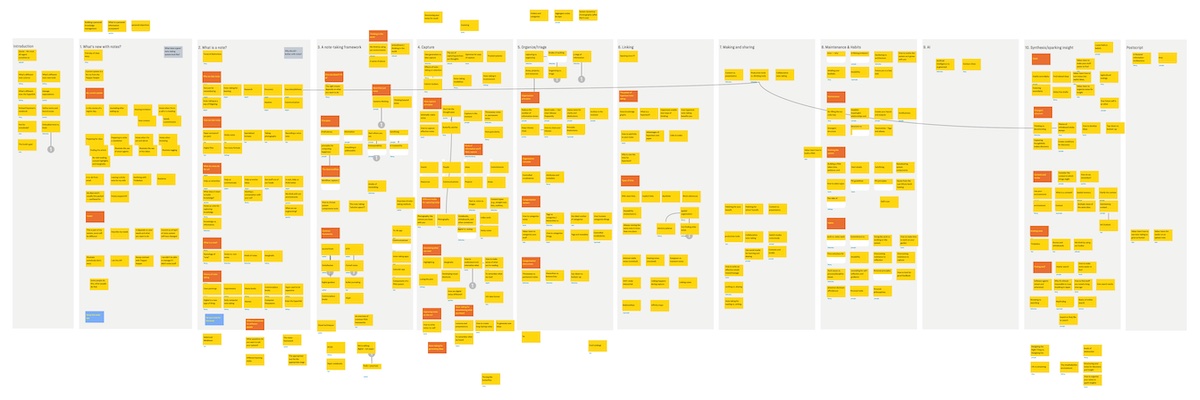A version of this post first appeared in my newsletter. Subscribe to receive posts like this in your inbox every other Sunday.
Last week, I was part of a book launch for UX Latam, a book for which I collaborated on a chapter. One of the folks tuning in to the stream asked a question worth expanding on: do you have tips for writing books?
Why yes, I do. Although I’m less prolific than some authors, I have some experience. I’m working on my third (non-fiction) book project, have contributed chapters to two other books, written a couple of journal papers, and blogged regularly for two decades.
Books are different from other media. You must sustain the reader’s interest longer, which requires you to also sustain your interest. You won’t succeed if your attention drifts. So my first tip is: be sure you want to write a book to begin with.
Why are you writing about this subject? Are you the best person to write about it? What are you adding to the conversation? Must it be a book? (Your ideas may be better served by other media. E.g., YouTube.) I don’t mean to dissuade you — but again, you must be committed. There’s no half-assing a book.
You’re committed? Good. Then it’s time for the second tip: make writing a habit.
There’s a common misunderstanding about how creative work happens. Many people think they must work when they’re inspired. But it’s the other way around: working is a prerequisite for inspiration. Chuck Close put it well:
Inspiration is for amateurs. The rest of us just show up and get to work. If you wait around for the clouds to part and a bolt of lightning to strike you in the brain, you are not going to make an awful lot of work. All the best ideas come out of the process; they come out of the work itself.
For me, the only way to write a book is a bit at a time. I set aside two hours before everyone else wakes up — every day, no weekends or holidays off. This approach may seem excessive, but I lose momentum if I stop. And I love writing, so it’s not painful for me. But YMMV. (See why total commitment matters?)
It helps build your habit if you work with a structure. Which brings me to my third tip: structure your ideas.
In a post about overcoming writer’s block, Josh Seiden says writing consists of three distinct phases: researching, writing, and editing. Many aspiring writers conflate them, which makes the task more daunting. I agree, but add a fourth phase between researching and writing: structuring.
You can think of the structure as your book’s outline. You take the insights that emerge from your research and synthesize and organize them into a clear and logical sequence that readers can follow.
Your first pass will be wrong. You’ll be more confident with the order of some chapters and sections than others. That’s okay. As you write, you’ll learn how to tell the story. (It also helps to teach the material in a workshop or classroom setting.)

Starting with a bad structure is better than starting with no structure; you’ll be able to apportion the work into small chunks you can take on daily. And if you write using an app like Scrivener or Ulysses, you can easily reorganize the structure later. (You will.)
The fourth tip will help you structure the book. It’s something I learned from my editor, Marta Justak. (Hi, Marta!) When you outline your ideas, you’ll find that many work together in different ways. One idea or story may fit in one chapter but also somewhere else. How do you decide?
One way to do it is by assigning a focusing question to each chapter. A focusing question is the main question the chapter will answer for the reader. For example, here are a few focusing questions from the book I’m currently working on, Duly Noted:
| Chapter title | Focusing question |
|---|---|
| Capturing notes | How do I keep ideas from getting away? |
| Organizing notes | How can I ensure I find stuff later? |
| Linking notes | How do I connect related ideas? |
Readers won’t see these questions; they’re just there to keep me on target. But note that they’re written from the reader’s perspective.
Whenever you have an idea for the chapter, ask yourself: does it help answer the focusing question? Will it clarify the chapter’s main point? If not, set it aside. (Again, you won’t have to lose the idea if you use a tool like Scrivener or Ulysses.)
The final tip is about the research process: ABC, always be capturing. (Hat tip to the Glengarry Glen Ross fans out there.)
While working on the book, you’ll come across relevant stories, ideas, quotations, etc. Some will appear when you’re researching the book; others will arrive serendipitously. (Look up the Baader-Meinhof phenomenon.) You won’t be able to keep it all in your brain.
Have a place to collect these ideas. It could be a physical folder or notebook, or an app. Just have somewhere you’ll find this stuff when you need it. (BTW, this is the subject of Duly Noted.)
Writing a book is very rewarding – and requires a lot of work. It can either be painful drudgery, or lots of fun. It comes down to many factors, but attitude, discipline, and structure help. If you’re considering it, I hope these tips help.
